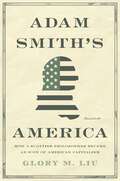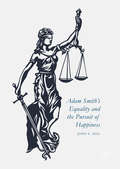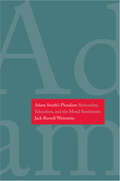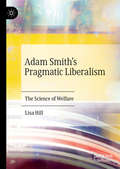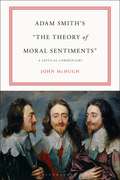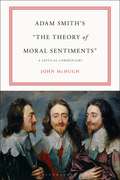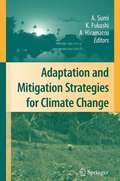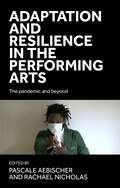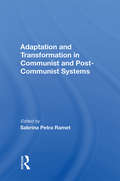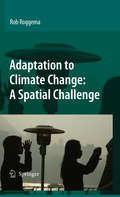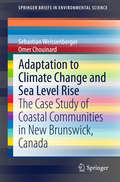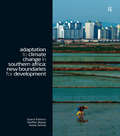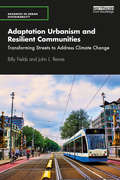- Table View
- List View
Adam Smith’s America: How a Scottish Philosopher Became an Icon of American Capitalism
by Glory M. LiuThe unlikely story of how Americans canonized Adam Smith as the patron saint of free marketsOriginally published in 1776, Adam Smith&’s The Wealth of Nations was lauded by America&’s founders as a landmark work of Enlightenment thinking about national wealth, statecraft, and moral virtue. Today, Smith is one of the most influential icons of economic thought in America. Glory Liu traces how generations of Americans have read, reinterpreted, and weaponized Smith&’s ideas, revealing how his popular image as a champion of American-style capitalism and free markets is a historical invention.Drawing on a trove of illuminating archival materials, Liu tells the story of how an unassuming Scottish philosopher captured the American imagination and played a leading role in shaping American economic and political ideas. She shows how Smith became known as the father of political economy in the nineteenth century and was firmly associated with free trade, and how, in the aftermath of the Great Depression, the Chicago School of Economics transformed him into the preeminent theorist of self-interest and the miracle of free markets. Liu explores how a new generation of political theorists and public intellectuals has sought to recover Smith&’s original intentions and restore his reputation as a moral philosopher.Charting the enduring fascination that this humble philosopher from Scotland has held for American readers over more than two centuries, Adam Smith&’s America shows how Smith continues to be a vehicle for articulating perennial moral and political anxieties about modern capitalism.
Adam Smith’s Equality and the Pursuit of Happiness
by John E. HillThis book examines Adam Smith’s main principles in Wealth of Nations as the basis for effective policymaking. Adam Smith wanted to increase happiness through this formula for a good life: equality, liberty, and justice. Free market interpretations of Smith, the book argues, grossly misrepresent his thought, emphasizing only liberty and not also equality and justice. This book suggests policies that combine all three in order for happiness to be maximized.
Adam Smith's Pluralism: Rationality, Education, and the Moral Sentiments
by Jack Russell WeinsteinIn this thought-provoking study, Jack Russell Weinstein suggests the foundations of liberalism can be found in the writings of Adam Smith (1723–1790), a pioneer of modern economic theory and a major figure in the Scottish Enlightenment. While offering an interpretive methodology for approaching Smith’s two major works, The Theory of Moral Sentiments and The Wealth of Nations, Weinstein argues against the libertarian interpretation of Smith, emphasizing his philosophies of education and rationality. Weinstein also demonstrates that Smith should be recognized for a prescient theory of pluralism that prefigures current theories of cultural diversity.
Adam Smith’s Pragmatic Liberalism: The Science of Welfare
by Lisa HillAdam Smith is commonly conceived as either an economist or a moral philosopher so his importance as a political thinker has been somewhat neglected and, at times, even denied. This book reveals the integrated, deeply political project that lies at the heart of Smith’s thought, showing both the breadth and novelty of Smith’s approach to political thought. A key argument running through the book is that attempts to locate Smith on the left-right spectrum (however that was interpreted in the eighteenth century) are mistaken: his position was ultimately dictated by his social scientific and economic thought rather than by ideology or principle. Through examining Smith’s political interests and positions, this book reveals that apparent tensions in Smith's thought are generally a function of his willingness to abandon, not only proto-liberal principles, but even the principles of his own social science when the achievement of good outcomes was at stake. Despite the common perception, negative liberty was not the be-all and end-all for Smith; rather, welfare was his main concern and he should therefore be understood as a thinker just as interested in what we would now call positive liberty. The book will uniquely show that Smith’s approach was basically coherent, not muddled, ad hoc, or ‘full of slips’; in other words, that it is a system unified by his social science and his practical desire to maximise welfare.
Adam Smith’s "The Theory of Moral Sentiments": A Critical Commentary
by John McHughMany contemporary readers are just now discovering Adam Smith's The Theory of Moral Sentiments (TMS). It is increasingly being recognised as a foundational text in moral philosophy and in Adam Smith's oeuvre more generally. This is the first companion to guide readers through TMS and uncover what Smith thinks, why he thinks it, why he might be wrong to think it! While Adam Smith is best known for a Wealth of Nations there is a history of seriously misinterpreting this text as an unnuanced celebration of unfettered capitalism. The Theory of Moral Sentiments is a kind of corrective to these naïve readings. As such, any serious consideration of Adam Smith's work should also include TMS. John McHugh's guide provides detailed analysis of TMS while never losing sight of the text in the context of Smith's writings and world view more generally. It offers both an introduction to the importance and insight of TMS while also functioning as a great way in to Adam Smith as a philosopher.
Adam Smith’s "The Theory of Moral Sentiments": A Critical Commentary
by John McHughMany contemporary readers are just now discovering Adam Smith's The Theory of Moral Sentiments (TMS). It is increasingly being recognised as a foundational text in moral philosophy and in Adam Smith's oeuvre more generally. This is the first companion to guide readers through TMS and uncover what Smith thinks, why he thinks it, why he might be wrong to think it! While Adam Smith is best known for a Wealth of Nations there is a history of seriously misinterpreting this text as an unnuanced celebration of unfettered capitalism. The Theory of Moral Sentiments is a kind of corrective to these naïve readings. As such, any serious consideration of Adam Smith's work should also include TMS. John McHugh's guide provides detailed analysis of TMS while never losing sight of the text in the context of Smith's writings and world view more generally. It offers both an introduction to the importance and insight of TMS while also functioning as a great way in to Adam Smith as a philosopher.
The Adams-Jefferson Letters: The Complete Correspondence Between Thomas Jefferson and Abigail and John Adams (Published by the Omohundro Institute of Early American History and Culture and the University of North Carolina Press)
by Lester J. CapponAn intellectual dialogue of the highest plane achieved in America, the correspondence between John Adams and Thomas Jefferson spanned half a century and embraced government, philosophy, religion, quotidiana, and family griefs and joys. First meeting as delegates to the Continental Congress in 1775, they initiated correspondence in 1777, negotiated jointly as ministers in Europe in the 1780s, and served the early Republic--each, ultimately, in its highest office. At Jefferson's defeat of Adams for the presidency in 1800, they became estranged, and the correspondence lapses from 1801 to 1812, then is renewed until the death of both in 1826, fifty years to the day after the Declaration of Independence.Lester J. Cappon's edition, first published in 1959 in two volumes, provides the complete correspondence between these two men and includes the correspondence between Abigail Adams and Jefferson. Many of these letters have been published in no other modern edition, nor does any other edition devote itself exclusively to the exchange between Jefferson and the Adamses. Introduction, headnotes, and footnotes inform the reader without interrupting the speakers. This reissue of The Adams-Jefferson Letters in a one-volume unabridged edition brings to a broader audience one of the monuments of American scholarship and, to quote C. Vann Woodward, 'a major treasure of national literature.'
Adams vs. Jefferson: The Tumultuous Election of 1800 (Pivotal Moments in American History)
by John FerlingIt was a contest of titans: John Adams and Thomas Jefferson, two heroes of the Revolutionary era, once intimate friends, now icy antagonists locked in a fierce battle for the future of the United States. The election of 1800 was a thunderous clash of a campaign that climaxed in a deadlock in the Electoral College and led to a crisis in which the young republic teetered on the edge of collapse. Adams vs. Jefferson is the gripping account of a turning point in American history, a dramatic struggle between two parties with profoundly different visions of how the nation should be governed. The Federalists, led by Adams, were conservatives who favored a strong central government. The Republicans, led by Jefferson, were more egalitarian and believed that the Federalists had betrayed the Revolution of 1776 and were backsliding toward monarchy. The campaign itself was a barroom brawl every bit as ruthless as any modern contest, with mud-slinging, scare tactics, and backstabbing. The low point came when Alexander Hamilton printed a devastating attack on Adams, the head of his own party, in "fifty-four pages of unremitting vilification." The stalemate in the Electoral College dragged on through dozens of ballots. Tensions ran so high that the Republicans threatened civil war if the Federalists denied Jefferson the presidency. Finally a secret deal that changed a single vote gave Jefferson the White House. A devastated Adams left Washington before dawn on Inauguration Day, too embittered even to shake his rival's hand. With magisterial command, Ferling brings to life both the outsize personalities and the hotly contested political questions at stake. He shows not just why this moment was a milestone in U.S. history, but how strongly the issues--and the passions--of 1800 resonate with our own time.
Adams vs. Jefferson: The Tumultuous Election of 1800 (Pivotal Moments in American History)
by John FerlingIt was a contest of titans: John Adams and Thomas Jefferson, two heroes of the Revolutionary era, once intimate friends, now icy antagonists locked in a fierce battle for the future of the United States. The election of 1800 was a thunderous clash of a campaign that climaxed in a deadlock in the Electoral College and led to a crisis in which the young republic teetered on the edge of collapse. Adams vs. Jefferson is the gripping account of a turning point in American history, a dramatic struggle between two parties with profoundly different visions of how the nation should be governed. The Federalists, led by Adams, were conservatives who favored a strong central government. The Republicans, led by Jefferson, were more egalitarian and believed that the Federalists had betrayed the Revolution of 1776 and were backsliding toward monarchy. The campaign itself was a barroom brawl every bit as ruthless as any modern contest, with mud-slinging, scare tactics, and backstabbing. The low point came when Alexander Hamilton printed a devastating attack on Adams, the head of his own party, in "fifty-four pages of unremitting vilification." The stalemate in the Electoral College dragged on through dozens of ballots. Tensions ran so high that the Republicans threatened civil war if the Federalists denied Jefferson the presidency. Finally a secret deal that changed a single vote gave Jefferson the White House. A devastated Adams left Washington before dawn on Inauguration Day, too embittered even to shake his rival's hand. With magisterial command, Ferling brings to life both the outsize personalities and the hotly contested political questions at stake. He shows not just why this moment was a milestone in U.S. history, but how strongly the issues--and the passions--of 1800 resonate with our own time.
Adaptable Autocrats: Regime Power in Egypt and Syria (Stanford Studies in Middle Eastern and Islamic Societies and Cultures #82)
by Joshua StacherThe decades-long resilience of Middle Eastern regimes meant that few anticipated the 2011 Arab Spring. But from the seemingly rapid leadership turnovers in Tunisia and Egypt to the protracted stalemates in Yemen and Syria, there remains a common outcome: ongoing control of the ruling regimes. While some analysts and media outlets rush to look for democratic breakthroughs, autocratic continuity—not wide-ranging political change—remains the hallmark of the region's upheaval. Contrasting Egypt and Syria, Joshua Stacher examines how executive power is structured in each country to show how these preexisting power configurations shaped the uprisings and, in turn, the outcomes. Presidential power in Egypt was centralized. Even as Mubarak was forced to relinquish the presidency, military generals from the regime were charged with leading the transition. The course of the Syrian uprising reveals a key difference: the decentralized character of Syrian politics. Only time will tell if Asad will survive in office, but for now, the regime continues to unify around him. While debates about election timetables, new laws, and the constitution have come about in Egypt, bloody street confrontations continue to define Syrian politics—the differences in authoritarian rule could not be more stark. Political structures, elite alliances, state institutions, and governing practices are seldom swept away entirely—even following successful revolutions—so it is vital to examine the various contexts for regime survival. Elections, protests, and political struggles will continue to define the region in the upcoming years. Examining the lead-up to the Egyptian and Syrian uprisings helps us unlock the complexity behind the protests and transitions. Without this understanding, we lack a roadmap to make sense of the Middle East's most important political moment in decades.
Adaptable Livelihoods: Coping with Food Insecurity in the Malian Sahel
by Susanna Davies'The book's radical message "save livelihoods not just lives" should be on the desk of every policy-maker concerned with relief and development and demands a rethink of policy and practice across the board.' - Robert Chambers, Institute of Development Studies 'A book on development I really enjoyed. An entriguing story emerges: the real expert on saving lives and livelihoods are the people facing famine and insecurity themselves. This book details the evolution of the local food monitoring system, showing that by concentrating on what people can do in response to change, rather than what they cannot do, we can devise more permanent and effective responses to food insecurity than emergency food aid distribution.' - Mike Aaronson, Save the Children Poor people living in high-risk environments live continuously with uncertainty which often threatens their livelihoods. They have therefore developed effective means of predicting and responding to large fluctuations in rainfall, harvest levels and natural resource production. These methods of prediction and response often out-perform conventional early warning systems promoted by donors and governments, and yet are rarely considered in the conception and implementation of food security programmes.
Adaptation and Mitigation Strategies for Climate Change
by Ai Hiramatsu Kensuke Fukushi Akimasa SumiIn recent decades there has been a growing awareness of how intricate the interactions are between human beings and the environment. Fortunately, progress has been made in understanding this relationship, and new technologies have been effective in addressing environmental problems. However belatedly, there has been an acknowledgment of the incompatibility of the world's finite resources with humankind's increasingly greater needs for them, and of how such a challenge demands broadened collaboration among engineers, social scientists, politicians and financial powers. Global agreement that the essential issues of the twenty-first century cannot be solved by any one discipline has led to the concept of sustainability. The transdisciplinary contributions selected for inclusion in this book address these concerns with an overview of the diverse fields of study related to sustainability. This collection of work is intended to pave the way for further collaboration among scientists and nations as well.
Adaptation and resilience in the performing arts: The pandemic and beyond (The pandemic and beyond)
by Pascale Aebischer Rachael NicholasThis book offers insights into some of the digital innovations, structural adaptations and analogue solutions that enabled live performance in the UK to survive through the COVID-19 pandemic. It provides evidence of values-led policies and practices that have improved the wellbeing of the creative workforce and have increased access to live performance. Through sections that address digital innovations, workforce resilience and programming live performances outdoors and in community settings, this book provides practical insights into the challenges live performance faced during the pandemic. It shows how, in order to survive, individuals and companies within the sector drew on the creativity and resourcefulness of its workforce, and on new and existing networks. In these accounts, the pandemic functioned as catalyst for technological innovations, stock-taking regarding exploitative industry structures, and a re-valuing of the role of live performance for community-building.
Adaptation and resilience in the performing arts: The pandemic and beyond (The pandemic and beyond)
by Pascale Aebischer and Rachael NicholasThis book offers insights into some of the digital innovations, structural adaptations and analogue solutions that enabled live performance in the UK to survive through the COVID-19 pandemic. It provides evidence of values-led policies and practices that have improved the wellbeing of the creative workforce and have increased access to live performance. Through sections that address digital innovations, workforce resilience and programming live performances outdoors and in community settings, this book provides practical insights into the challenges live performance faced during the pandemic. It shows how, in order to survive, individuals and companies within the sector drew on the creativity and resourcefulness of its workforce, and on new and existing networks. In these accounts, the pandemic functioned as catalyst for technological innovations, stock-taking regarding exploitative industry structures, and a re-valuing of the role of live performance for community-building.
Adaptation And Transformation In Communist And Post-communist Systems
by Sabrina Petra RametThis book tackles different aspects of the adaptive and transformative process in communist and post-communist systems in Eastern Europe, offering competing models, which locate the explanatory variable in different places and account for the unfolding of change in different ways.
Adaptation And Transformation In Communist And Post-communist Systems
by Sabrina Petra RametThis book tackles different aspects of the adaptive and transformative process in communist and post-communist systems in Eastern Europe, offering competing models, which locate the explanatory variable in different places and account for the unfolding of change in different ways.
Adaptation, Poverty and Development: The Dynamics of Subjective Well-Being (Rethinking International Development series)
by David Alexander ClarkThe first book to examine in detail the ways in which people adapt their understanding and behaviours towards poverty as a direct result to their experiences of poverty in developing countries, including world-leading academics and case studies from China, India, Ethiopia and South Africa.
Adaptation to Climate Change: A Spatial Challenge
by Rob RoggemaAs it becomes clear that climate change is not easily within the boundaries of the 1990’s, society needs to be prepared and needs to anticipate future changes due to the uncertain changes in climate. So far, extensive research has been carried out on several issues including the coastal defence or shifting ecozones. However, the role spatial design and planning can play in adapting to climate change has not yet been focused on. This book illuminates the way adaptation to climate change is tackled in water management, ecology, coastal defence, the urban environment and energy. The question posed is how each sector can anticipate climate change by creating spatial designs and plans. The main message of this book is that spatial design and planning are a very useful tool in adapting to climate change. It offers an integral view on the issue, it is capable in dealing with uncertainties and it opens the way to creative and anticipative solutions. Dealing with adaptation to climate change requires a shift in mindset; from a technical rational way of thinking towards an integral proactive one. A new era in spatial design and planning looms on the horizon.
Adaptation to Climate Change and Sea Level Rise: The Case Study of Coastal Communities in New Brunswick, Canada (SpringerBriefs in Environmental Science)
by Sebastian Weissenberger Omer ChouinardThe book provides a concise and interdisciplinary outlook on the impacts of climate change on coastal areas and how coastal communities adapt to them. The first chapter analyses how sea level rise, changing ocean conditions, or increased climate variability and the socio-environmental context of the coastal zone leads to vulnerable communities. The second chapter addresses adaptation strategies and tools, and gives some examples of their application around the world. The third chapter describes participative action research projects undertaken in New Brunswick and how this community based approach has enabled communities to increase their climate resilience.
Adaptation to Climate Change in Southern Africa: New Boundaries for Development (Climate and Development Series)
by Steffen Bauer Imme ScholzAdverse climate impacts are already evident across Southern Africa and pose a serious threat to the development prospects of the region's societies. Sustainable development in this region will depend on the rapid development and implementation of effective adaptation measures. This volume identifies the new socioeconomic and political boundaries to development that result from ongoing climate change in Southern Africa. The collected papers explore the region's potential for a transition to development strategies that combine meaningful socioeconomic investment and adaptation measures while also improving livelihoods in the region. The chapters are backed up by detailed case studies which underscore the urgent need for national governments and multilateral agencies to develop strategies to support Southern Africa's societies in adapting to climate change.
Adaptation to Climate Change in Southern Africa: New Boundaries for Development (Climate and Development Series)
by Steffen Bauer Imme ScholzAdverse climate impacts are already evident across Southern Africa and pose a serious threat to the development prospects of the region's societies. Sustainable development in this region will depend on the rapid development and implementation of effective adaptation measures. This volume identifies the new socioeconomic and political boundaries to development that result from ongoing climate change in Southern Africa. The collected papers explore the region's potential for a transition to development strategies that combine meaningful socioeconomic investment and adaptation measures while also improving livelihoods in the region. The chapters are backed up by detailed case studies which underscore the urgent need for national governments and multilateral agencies to develop strategies to support Southern Africa's societies in adapting to climate change.
Adaptation under Fire: How Militaries Change in Wartime (BRIDGING THE GAP SERIES)
by Nora Bensahel Lt. General David BarnoA critical look into how and why the U.S. military needs to become more adaptable. Every military must prepare for future wars despite not really knowing the shape such wars will ultimately take. As former U.S. Secretary of Defense Robert Gates once noted: "We have a perfect record in predicting the next war. We have never once gotten it right." In the face of such great uncertainty, militaries must be able to adapt rapidly in order to win. Adaptation under Fire identifies the characteristics that make militaries more adaptable, illustrated through historical examples and the recent wars in Iraq and Afghanistan. Authors David Barno and Nora Bensahel argue that militaries facing unknown future conflicts must nevertheless make choices about the type of doctrine that their units will use, the weapons and equipment they will purchase, and the kind of leaders they will select and develop to guide the force to victory. Yet after a war begins, many of these choices will prove flawed in the unpredictable crucible of the battlefield. For a U.S. military facing diverse global threats, its ability to adapt quickly and effectively to those unforeseen circumstances may spell the difference between victory and defeat. Barno and Bensahel start by providing a framework for understanding adaptation and include historical cases of success and failure. Next, they examine U.S. military adaptation during the nation's recent wars, and explain why certain forms of adaptation have proven problematic. In the final section, Barno and Bensahel conclude that the U.S. military must become much more adaptable in order to address the fast-changing security challenges of the future, and they offer recommendations on how to do so before it is too late.
Adaptation under Fire: How Militaries Change in Wartime (Bridging the Gap)
by Nora Bensahel Lt. General David BarnoA critical look into how and why the U.S. military needs to become more adaptable. Every military must prepare for future wars despite not really knowing the shape such wars will ultimately take. As former U.S. Secretary of Defense Robert Gates once noted: "We have a perfect record in predicting the next war. We have never once gotten it right." In the face of such great uncertainty, militaries must be able to adapt rapidly in order to win. Adaptation under Fire identifies the characteristics that make militaries more adaptable, illustrated through historical examples and the recent wars in Iraq and Afghanistan. Authors David Barno and Nora Bensahel argue that militaries facing unknown future conflicts must nevertheless make choices about the type of doctrine that their units will use, the weapons and equipment they will purchase, and the kind of leaders they will select and develop to guide the force to victory. Yet after a war begins, many of these choices will prove flawed in the unpredictable crucible of the battlefield. For a U.S. military facing diverse global threats, its ability to adapt quickly and effectively to those unforeseen circumstances may spell the difference between victory and defeat. Barno and Bensahel start by providing a framework for understanding adaptation and include historical cases of success and failure. Next, they examine U.S. military adaptation during the nation's recent wars, and explain why certain forms of adaptation have proven problematic. In the final section, Barno and Bensahel conclude that the U.S. military must become much more adaptable in order to address the fast-changing security challenges of the future, and they offer recommendations on how to do so before it is too late.
Adaptation Urbanism and Resilient Communities: Transforming Streets to Address Climate Change (Advances in Urban Sustainability)
by Billy Fields John L. RenneAdaptation Urbanism and Resilient Communities outlines and explains adaptation urbanism as a theoretical framework for understanding and evaluating resilience projects in cities and relates it to pressing contemporary policy issues related to urban climate change mitigation and adaptation. Through a series of detailed case studies, this book uncovers the promise and tensions of a new wave of resilient communities in Europe (Copenhagen, Rotterdam, and London), and the United States (New Orleans and South Florida). In addition, best practice projects in Amsterdam, Barcelona, Delft, Utrecht, and Vancouver are examined. The authors highlight how these communities are reinventing the role of streets and connecting public spaces in adapting to and mitigating climate change through green/blue infrastructure planning, maintaining and enhancing sustainable transportation options, and struggling to ensure equitable development for all residents. The case studies demonstrate that while there are some more universal aspects to encouraging adaptation urbanism, there are also important local characteristics that need to be both acknowledged and celebrated to help local communities thrive in the era of climate change. The book also provides key policy lessons and a roadmap for future research in adaptation urbanism. Advancing resilience policy discourse through multidisciplinary framework this work will be of great interest to students of urban planning, geography, transportation, landscape architecture, and environmental studies, as well as resilience practitioners around the world.
Adaptation Urbanism and Resilient Communities: Transforming Streets to Address Climate Change (Advances in Urban Sustainability)
by Billy Fields John L. RenneAdaptation Urbanism and Resilient Communities outlines and explains adaptation urbanism as a theoretical framework for understanding and evaluating resilience projects in cities and relates it to pressing contemporary policy issues related to urban climate change mitigation and adaptation. Through a series of detailed case studies, this book uncovers the promise and tensions of a new wave of resilient communities in Europe (Copenhagen, Rotterdam, and London), and the United States (New Orleans and South Florida). In addition, best practice projects in Amsterdam, Barcelona, Delft, Utrecht, and Vancouver are examined. The authors highlight how these communities are reinventing the role of streets and connecting public spaces in adapting to and mitigating climate change through green/blue infrastructure planning, maintaining and enhancing sustainable transportation options, and struggling to ensure equitable development for all residents. The case studies demonstrate that while there are some more universal aspects to encouraging adaptation urbanism, there are also important local characteristics that need to be both acknowledged and celebrated to help local communities thrive in the era of climate change. The book also provides key policy lessons and a roadmap for future research in adaptation urbanism. Advancing resilience policy discourse through multidisciplinary framework this work will be of great interest to students of urban planning, geography, transportation, landscape architecture, and environmental studies, as well as resilience practitioners around the world.
